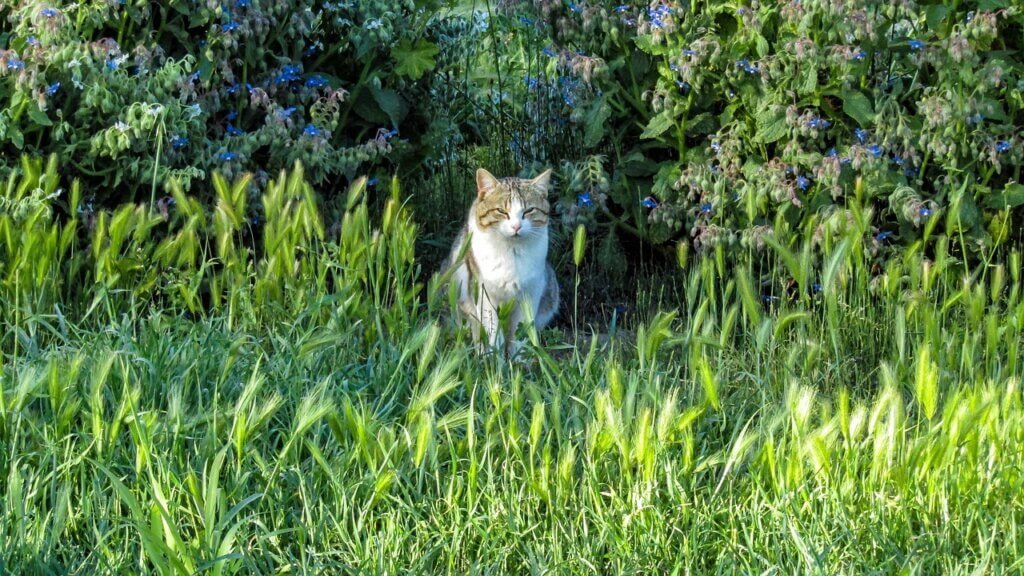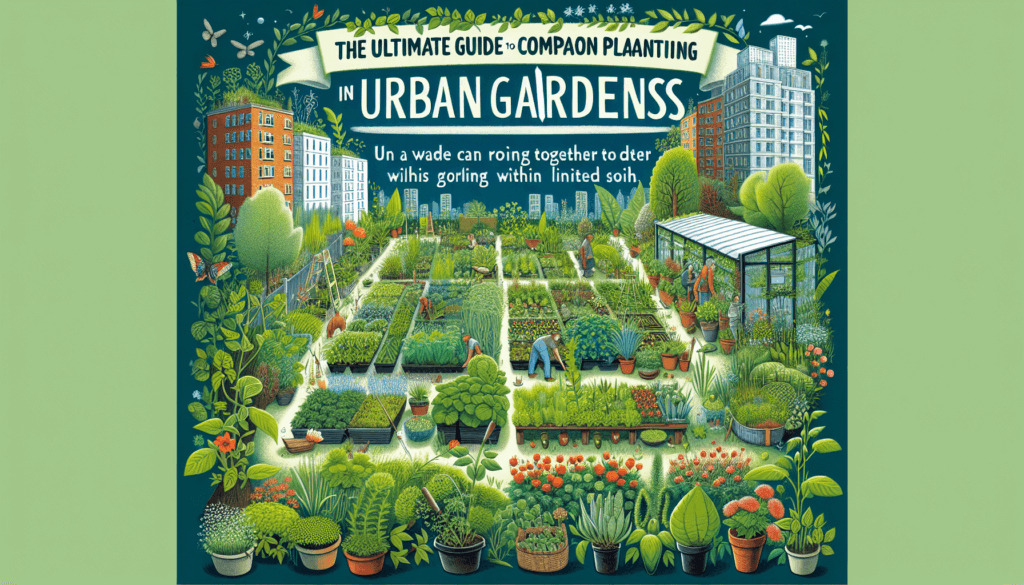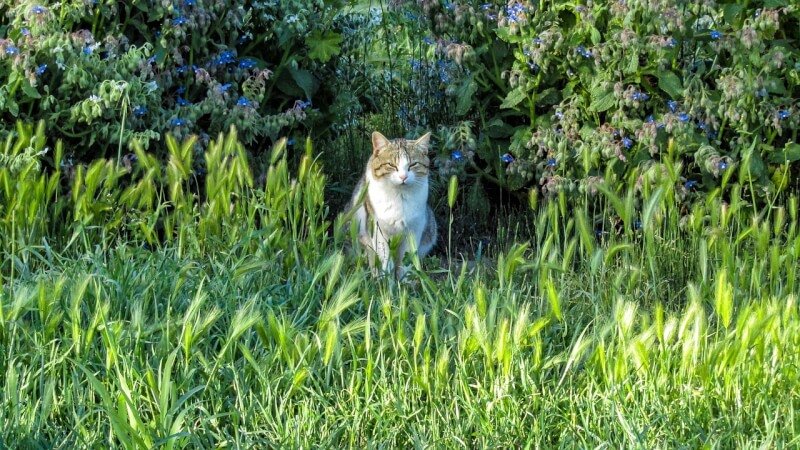Are you looking to create a thriving urban garden? Your journey begins with the ultimate guide to companion planting in urban gardens. In this comprehensive article, you will discover the secrets to planting different species of plants together, harnessing the power of symbiotic relationships, and maximizing your garden’s potential. Whether you have a small balcony or a rooftop oasis, this guide will equip you with the knowledge and tips to create a harmonious and bountiful urban garden. Get ready to unlock the full potential of your green thumb and transform your city dwelling into a flourishing oasis.

Why Companion Planting is Important in Urban Gardens
Urban gardens provide a wonderful opportunity for people to connect with nature and grow their own food, even in small spaces. However, these gardens often present certain challenges such as limited space, poor soil quality, and a higher prevalence of pests and diseases. This is where companion planting comes in. By strategically pairing certain plants together, you can enhance the health and productivity of your garden while reducing the need for synthetic pesticides and fertilizers. In this article, we will explore the importance of companion planting in urban gardens and provide a comprehensive guide to help you get started.
Benefits of Companion Planting
Companion planting offers numerous benefits for urban gardeners. First and foremost, it promotes natural pest control by attracting beneficial insects that prey on common garden pests. By creating a diverse and balanced ecosystem, you can reduce the need for chemical pest control methods. Additionally, companion planting improves soil fertility and structure. Some plants have the ability to fix nitrogen in the soil, while others help to break up compacted soil with their deep root systems. This helps to create a healthy growing environment for your plants. Furthermore, certain plant combinations can enhance pollination rates, leading to increased yields. Lastly, companion planting can provide shade and protection from sun for more delicate plants, as well as suppress the growth of weeds.

Challenges and Advantages in Urban Gardens
While companion planting offers various advantages, it is worth noting that urban gardens present unique challenges. Limited space is often a concern, as urban gardeners may not have the luxury of large plots of land. However, by utilizing vertical gardening techniques, such as trellises or vertical planters, you can maximize your growing space. Another challenge in urban gardens is poor soil quality. Many urban areas have soil contaminated with heavy metals or polluted with chemicals. To overcome this, raised beds or container gardening can be used, where you can control the quality of the soil. Additionally, urban gardens tend to have a higher concentration of pests and diseases due to the proximity of other gardens. Companion planting can help deter pests and reduce the risk of disease transfer, but it is important to carefully select plant combinations to avoid attracting more pests.
Understanding Companion Planting
What is Companion Planting?
Companion planting is the practice of strategically growing certain plants together to benefit one or both of the plants. By choosing suitable companion plants, you can create a mutually beneficial relationship where they support each other’s growth and health.
Principles of Companion Planting
Companion planting is rooted in the idea that certain plants have the ability to enhance the growth of neighboring plants. This can be achieved through various mechanisms, such as repelling pests, attracting beneficial insects, improving soil fertility, or providing shade and support. By following the principles of companion planting, you can harness these natural interactions and optimize the productivity of your garden.
Complementary and Mutually Beneficial Plant Pairings
Companion planting relies on finding suitable plant pairings that complement each other’s needs. For example, some plants release natural chemicals that repel pests, while others may attract beneficial insects that prey on those pests. Some plants have deep root systems that help to break up compacted soil, making it easier for neighboring plants to access nutrients. Additionally, certain plants have different growth habits that can provide shade or support for other plants. By understanding the characteristics and needs of different plant species, you can create harmonious plant communities that thrive together.

Selecting the Right Companion Plants
Types of Companion Plants
There are three main types of companion plants: pest-repellent plants, attractant plants, and nutrient accumulators. Pest-repellent plants, as the name suggests, deter pests from attacking neighboring plants. Examples include marigolds, which repel nematodes, and garlic, which repels aphids. Attractant plants, on the other hand, attract beneficial insects that prey on common garden pests. For instance, alyssum attracts hoverflies and ladybugs, which feed on aphids. Nutrient accumulators are plants that have deep root systems and can accumulate nutrients from deep within the soil, which benefits neighboring plants that may have shallower roots. Examples include comfrey and legumes like peas and beans, which fix nitrogen in the soil.
Considerations for Urban Gardens
When selecting companion plants for urban gardens, it is important to consider the limited space available. Opt for plants that are compact or have a vertical growth habit, such as trellis-climbing plants or dwarf varieties. This will help you make the most efficient use of your space. Additionally, consider the amount of sunlight your garden gets throughout the day and choose plants that have similar light requirements to ensure they can thrive together.
Choosing Plants with Similar Needs
To ensure successful companion planting, it is crucial to select plants that have similar needs in terms of water, soil type, and sunlight. By pairing plants with similar requirements, you can optimize their growth and reduce competition. For example, if you have a group of plants that require full sun, avoid planting shade-tolerant plants nearby as they may overshadow and stunt the growth of the sun-loving plants.
Suitable Combinations for Different Crops
Different crops have different companion planting preferences. Here are some popular and successful pairings:
Tomatoes and basil: Basil enhances the flavor of tomatoes and repels tomato hornworms.
Carrots and onions: Carrots and onions thrive in each other’s presence and help deter pests like carrot flies and onion maggots.
Cucumber and radish: Radishes act as a pest deterrent for cucumbers and are harvested before the cucumber vines spread.
Lettuce and chives: Chives help repel aphids that can damage lettuce leaves.
Beans and corn: Beans provide nitrogen to the soil, benefiting corn, while cornstalks provide support for the climbing beans.
Marigolds and tomatoes: Marigolds repel nematodes and other insects harmful to tomatoes.
Nasturtiums and squash: Nasturtiums repel squash bugs and attract pollinators.
Lavender and rosemary: Lavender and rosemary are drought-tolerant, making them suitable companions.
Rosemary and sage: Rosemary and sage deter pests like cabbage moths when planted near brassicas.
Mint and cabbage: Mint acts as a natural repellent for cabbage pests like cabbage worms.
Popular Companion Plant Pairings
Companion planting has been practiced for centuries, and certain pairings have become well-known for their success in gardens. Here are some popular companion plant pairings:
Tomatoes and Basil
Tomatoes and basil are a classic companion planting combination. The aromatic scent of basil deters tomato hornworms and enhances the flavor of tomatoes. Planting basil near tomatoes also helps to repel aphids and other pests.
Carrots and Onions
Carrots and onions thrive when planted together. Onions discourage carrot flies, while carrots deter onion maggots. This mutual pest protection benefits both crops and reduces the need for synthetic pesticides.
Cucumber and Radish
Cucumbers and radishes make great companions in the garden. Radishes act as a trap crop, attracting cucumber beetles away from the cucumbers. They also mature before the cucumbers need the space, allowing for efficient use of garden space.
Lettuce and Chives
Lettuce and chives are an ideal pairing. Chives repel aphids, which can damage lettuce leaves. Planting chives near lettuce helps to protect the delicate greens from these pests, ensuring a healthy harvest.
Beans and Corn
Beans and corn have a symbiotic relationship. Beans have the ability to fix nitrogen in the soil, benefiting the corn crops. In return, the cornstalks provide support for the climbing beans. This combination also allows for efficient use of space, as the beans can utilize the vertical space provided by the corn.
Marigolds and Tomatoes
Marigolds are a popular companion plant for tomatoes. They repel nematodes and other insects harmful to tomatoes. Planting marigolds around tomato plants can help protect your crop from these pests, reducing the need for chemical interventions.
Nasturtiums and Squash
Nasturtiums and squash are a beneficial combination. Nasturtiums repel squash bugs, which can be detrimental to squash plants. Additionally, nasturtiums attract pollinators, aiding in the fertilization of squash flowers.
Lavender and Rosemary
Lavender and rosemary are both aromatic plants with similar growth requirements. They are drought-tolerant and well-suited for companion planting. These herbs not only add fragrance to your garden but also provide natural pest control by repelling certain insect pests.
Rosemary and Sage
Rosemary and sage make excellent companions for cabbage family plants, like broccoli and kale. They help deter cabbage moths and other pests that can damage these crops. Planting rosemary and sage near brassicas can provide additional protection against pests, reducing the need for chemical interventions.
Mint and Cabbage
Mint is known for its strong scent, which acts as a natural insect repellent. Planting mint near cabbage can help deter pests like cabbage worms. This combination not only enhances pest control but also adds a refreshing aroma to your garden.

Companion Planting Techniques
Intercropping
Intercropping is the practice of growing different crops close together to maximize space utilization and provide mutual benefits. By intercropping, you can create a diverse planting scheme that minimizes pest and disease pressure while maximizing productivity. This technique is especially useful in urban gardens where space is limited.
Trap Cropping
Trap cropping involves planting a sacrificial crop to attract pests away from the main crop. This technique works by luring pests toward the trap crop and away from the desired plant. For example, planting marigolds to attract aphids away from your lettuce or planting radishes to lure cucumber beetles away from your cucumbers.
Nurse Plants
Nurse plants are larger, established plants that provide shelter and support for smaller, vulnerable plants. They create a microclimate that protects the young seedlings from harsh weather conditions and predation. For example, tall sunflowers can act as nurse plants for delicate lettuce seedlings.
Succession Planting
Succession planting involves planting new crops as soon as the previous ones are harvested. This technique ensures a continuous supply of fresh produce throughout the growing season. By carefully selecting companion crops for succession planting, you can create a continuous cycle of planting, harvesting, and replanting.
Vertical Planting
Vertical planting is a space-saving technique that involves growing plants vertically, such as with the help of trellises, stakes, or fences. By utilizing vertical space, you can grow more plants in a smaller area. This technique is particularly useful for vining plants like cucumbers, peas, and beans.
Border and Edge Planting
Border and edge planting refers to the practice of planting companion plants along the borders or edges of your garden beds. This creates a natural barrier that can deter pests from entering the growing area. For example, planting marigolds or garlic along the edges of your vegetable beds can help repel pests like aphids or nematodes.
Polyculture vs. Monoculture
Polyculture refers to the practice of growing multiple plant species together, while monoculture involves growing a single crop over a large area. In companion planting, polyculture is generally recommended as it creates a more diverse and resilient ecosystem. By contrast, monoculture can increase the risk of pest and disease outbreaks.
Complementary Planting Principles
Companion Plants for Pest Control
Companion planting can help control pests by attracting beneficial insects that prey on common garden pests. For example, planting alyssum alongside your vegetables can attract hoverflies and ladybugs, which feed on aphids. Similarly, planting dill or fennel near brassicas can attract beneficial insects that control caterpillars and aphids.
Attracting Beneficial Insects
In addition to repelling pests, companion planting also aims to attract beneficial insects that aid in pollination and pest control. Pollinators like bees, butterflies, and hoverflies play a vital role in the reproduction of flowering plants. By planting flowers that attract these beneficial insects, you can enhance pollination rates and increase fruit or vegetable yields.
Improving Soil Fertility
Companion planting can improve soil fertility through the use of nutrient accumulators. Legumes like peas and beans have the ability to fix atmospheric nitrogen in the soil, making it available for other plants. By incorporating nitrogen-fixing plants into your garden, you can reduce the need for synthetic fertilizers and improve the overall health of your soil.
Planting for Shade and Sun Protection
In urban gardens where sunlight can be limited, companion planting can provide shade and sun protection for more delicate plants. Taller plants, such as sunflowers or corn, can be strategically placed to provide shade for plants that prefer cooler conditions or are sensitive to intense sunlight. This creates a microclimate that helps regulate temperature and reduces stress on plants.
Enhancing Pollination
Companion planting can greatly enhance pollination rates, leading to improved fruit set and higher yields. Many fruiting plants, such as cucumbers and melons, rely on insect pollinators to transfer pollen between flowers. By planting companion flowers that attract bees and other pollinators, you can ensure optimal pollination and increase the chances of a bountiful harvest.
Suppressing Weeds
Companion planting can play a role in weed management by suppressing the growth of weeds. Some plants, like clover or vetch, have dense foliage that helps to smother weeds and prevent them from establishing. By interplanting these “living mulches” with your vegetable crops, you can reduce weed competition and minimize the need for manual weeding.

Avoiding Negative Plant Combinations
Plants with Allelopathic Effects
Some plants release chemicals that inhibit the growth of other plants. This phenomenon, known as allelopathy, can have negative effects on nearby plants. For example, black walnut trees release juglone, a compound that inhibits the growth of many plants, including tomatoes. It is important to be aware of the allelopathic effects of certain plants and avoid planting incompatible species together.
Competitive and Incompatible Pairings
Certain plant combinations can be competitive and negatively affect each other’s growth. For example, planting fruits or vegetables with shallow root systems near plants with deep root systems can result in competition for water and nutrients. It is important to consider the space requirements and growth habits of different plants to ensure they are compatible and will not hinder each other’s growth.
Plants Prone to Disease Transfer
Companion planting should also take into account the potential for disease transfer between plants. Some plant species are more susceptible to certain diseases than others. For instance, planting tomatoes near potatoes can increase the risk of late blight, a common disease that affects both crops. Understanding the disease vulnerabilities of different plants will help you make informed choices when selecting companion plants.
Implementing Companion Planting in Small Spaces
Vertical Gardening Techniques
Vertical gardening techniques are particularly useful for maximizing space in small gardens. By using trellises, stakes, or wall-mounted planters, you can grow plants vertically and take advantage of underutilized space. Vining crops like tomatoes, beans, or cucumbers are well-suited for vertical gardening, as they can climb and utilize vertical structures for support.
Container Gardening
Container gardening is an excellent option for urban gardens with limited space. By growing plants in containers, you can have more control over the soil quality and easily move the plants to optimize sunlight exposure. Vegetables like lettuce, herbs, and dwarf varieties of tomatoes or peppers are well-suited for container gardening.
Window Boxes and Hanging Baskets
Window boxes and hanging baskets are perfect for adding greenery and growing herbs or flowers in small spaces. By utilizing vertical surfaces like windows or balcony railings, you can create a mini garden that enhances the visual appeal of your living space. Herbs like basil, thyme, or parsley thrive in window boxes and hanging baskets.
Herbs and Vegetables That Grow Well in Limited Space
When space is a constraint, choosing compact or dwarf varieties of plants is key. Many herbs and vegetables have miniature or bushy varieties that are well-suited for small gardens. Examples include cherry tomatoes, patio peppers, bush beans, compact herbs like oregano or chives, and smaller lettuces or salad greens.
Additional Tips for Successful Companion Planting
Crop Rotation
Crop rotation is an essential practice in companion planting and overall garden management. By rotating your crops each year, you can prevent the buildup of pests and diseases in the soil. Ideally, aim for a three-year rotation, where you avoid planting the same crop or its close relatives in the same area for at least three years.
Planting Density and Spacing
Pay attention to the recommended planting density and spacing for each crop to ensure optimal growth and reduce competition. Overcrowding can result in stunted growth and increased susceptibility to disease. On the other hand, underplanting can leave gaps that weeds can easily fill. Follow the guidelines for appropriate spacing to promote healthier plants and efficient use of space.
Caring for Companion Plants
Proper care is essential for the success of companion plants. Regular watering, fertilizing if necessary using organic methods, and monitoring for pests and diseases are crucial steps in maintaining the overall health of your garden. Additionally, pruning or thinning plants when required helps improve air circulation and reduces the risk of diseases.
Observation and Experimentation
Observing your companion plants and documenting their growth and interactions is key to understanding what works best in your specific garden. Not all companion plant pairings have the same effects in every garden due to variations in microclimates, soil conditions, and pest populations. By observing and experimenting with different combinations, you can fine-tune your companion planting strategies and optimize the benefits for your garden.
Record Keeping and Plant Logs
Keeping a record of your planting schemes and the successes or challenges you encounter can be a valuable resource for future reference. Note down which companion plants worked well together, which combination had negative effects, and any other observations you make throughout the growing season. This log will serve as a useful guide for planning future plantings and avoiding any potential pitfalls.
Conclusion
Companion planting is a powerful technique that can transform your urban garden into a thriving, productive, and ecologically balanced space. By understanding the principles of companion planting and selecting the right plant combinations, you can harness the benefits of natural pest control, improved soil fertility, and enhanced pollination. Additionally, implementing various companion planting techniques, such as intercropping or vertical gardening, can help you make the most of limited space. Remember to consider the specific needs and characteristics of your plants, and don’t be afraid to experiment and adapt your approach based on your observations. With a little planning and attention, companion planting can elevate your urban garden to new heights of productivity and beauty.


